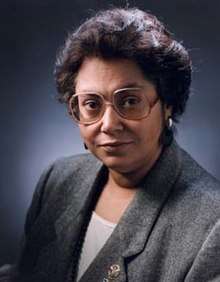Patricia S. Cowings
Patricia S. Cowings (born 1948) is an aerospace psychophysiologist, and was the first African American woman scientist to be trained as an astronaut by NASA (though Sally Ride was the first American woman to fly in space).[1] Although she was an alternate for a space flight in 1979 she did not travel to space.[2] She is most well known for her studies in the physiology of astronauts in outer space, as well as helping find cures for astronaut's motion sickness.[3][4][5]
Patricia S. Cowings | |
|---|---|
 NASA photograph of Dr. Patricia S. Cowings | |
| Born | Patricia S. Cowings December 15, 1948 The Bronx, New York City, New York, U.S. |
| Nationality | American |
| Education | State University of New York at Stony Brook (BA Psychology); University of California Davis (MA Psychology; Ph.D. Psychology) |
| Occupation | Psychophysiology |
| Spouse(s) | William B. Toscano
( m. 1980) |
| Parent(s) |
|
| Awards |
|
Early life and family
Cowings was born and raised in The Bronx, New York City on December 15, 1948. She is the only daughter of Sadie B. and Albert S. Cowings. Sadie was an assistant preschool teacher. Albert was a grocery store owner. She had three other brothers who went on to become a two-star army general, a jazz musician, and a freelance journalist. Her parents emphasized education as a "way of getting out of the Bronx."[6]
Education
Patricia found her love for science at a young age. Patricia was involved in African dance and step and graduated with a bachelors in the arts. Psychology and later psychophysiology showed her how to enhance human potential. 'What better field is there than to study the animal who created all the other fields? Humans!' This love was further helped by her psychologist aunt, whom she considered a deep inspiration because she had earned a PhD. Taking an engineering class in grad school where she took part in designing a space shuttle helped launch her desire to work in the field of space technology.[7]
Career
She did most of her research at NASA Ames Research Center. There she developed and patented a physiological training system called Autogenic-Feedback Training Exercise (AFTE), which enables people to learn voluntary self-control of up to 24 bodily responses in six hours. Her work was first tested in 1985 for (STS 51-b & STS 51c) Spacelab-3 and the first DOD shuttle mission. She tested her AFTE training method also on the Space J-Lab Mission (the first Japanese shuttle mission), with her work focusing on ridding of the astronaut's motion sickness.[1][3] Later she trained four cosmonauts to control both motion sickness and low blood pressure after six-months in space aboard the MIR space station. She found success, and continued to teach people how to control motion sickness, improve performance of search & rescue pilots, and reduce symptoms of several patient populations suffering from nausea, dizziness and fainting. She has helped author several publications with her husband, William B. Toscano. They have a son, Christopher Michael Cowings Toscano, who traveled with them as they trained space crews.
Today, she continues her work helping to prevent motion sickness for astronauts in space, as well as helping control motion sickness for their return home.[7] She is the principal investigator of Psychophysiological Research Laboratories at NASA Ames Research Center, and has held adjunct professorships in Psychiatry at UCLA and both medical and clinical psychology at the uniformed services university. (ARC).[1]
Awards and honors
Her research and teaching has garnered her several awards, including:[3]
- Candace Award, National Coalition of 100 Black Women (1989)[8]
- NASA Individual Achievement Award (1993)
- Black Engineer of the Year Award (1997) [9]
- AMES Honor Award for Technology Development (1999)
- NASA Space Act Award for Invention (2002)
- National Women of Color Technology Award (2006) [9]
- NASA Space Act Board Award (2008) [9]
- Ames African American Advisory Group's (AAAG) Achievement Award (2010) [9]
- Celestial Torch Award from the National Society of Black Engineers (NSBE) in Los Angeles (2014) [9]
References
- Cowings, Patricia. "Patricia S. Cowings, Ph. D". thebannekerinstitute.org. The Benjamin Banneker Institute for Science and Technology. Archived from the original on April 12, 2016.
- >"Patricia Cowings, PhD, NASA psychopysiologist". American Psychological Association. Archived from the original on February 10, 2015.
- Wayne, Tiffany (2011). American Women of Science Since 1900. 130 Cremona Drive, P.O. Box 1911 Santa Barbara, California 93116 1911: ABC CLIO, LLC. pp. 320–321. ISBN 978-1-59884-158-9.CS1 maint: location (link)
- Notable Black American women. Smith, Jessie Carney, 1930-, Phelps, Shirelle. Detroit: Gale Research. 1996. ISBN 9780810391772. OCLC 24468213.CS1 maint: others (link)
- 1964-, Oakes, Elizabeth H. (2007). Encyclopedia of world scientists (Rev ed.). New York: Facts on File. ISBN 9780816061587. OCLC 83610106.CS1 maint: numeric names: authors list (link)
- 1934-, Gubert, Betty Kaplan (2002). Distinguished African Americans in aviation and space science. Sawyer, Miriam., Fannin, Caroline M. Westport, Conn.: Oryx Press. ISBN 9781573562461. OCLC 47013254.CS1 maint: numeric names: authors list (link)
- Cowings, Patricia. "Meet: Patricia Cowings, PhD". nasa.gov. NASA Quest. Archived from the original on March 5, 2016.
- "CANDACE AWARD RECIPIENTS 1982-1990, Page 2". National Coalition of 100 Black Women. Archived from the original on March 14, 2003.
- "Patricia S. Cowings". NASA Human Systems Integration Division. Archived from the original on December 2, 2016.